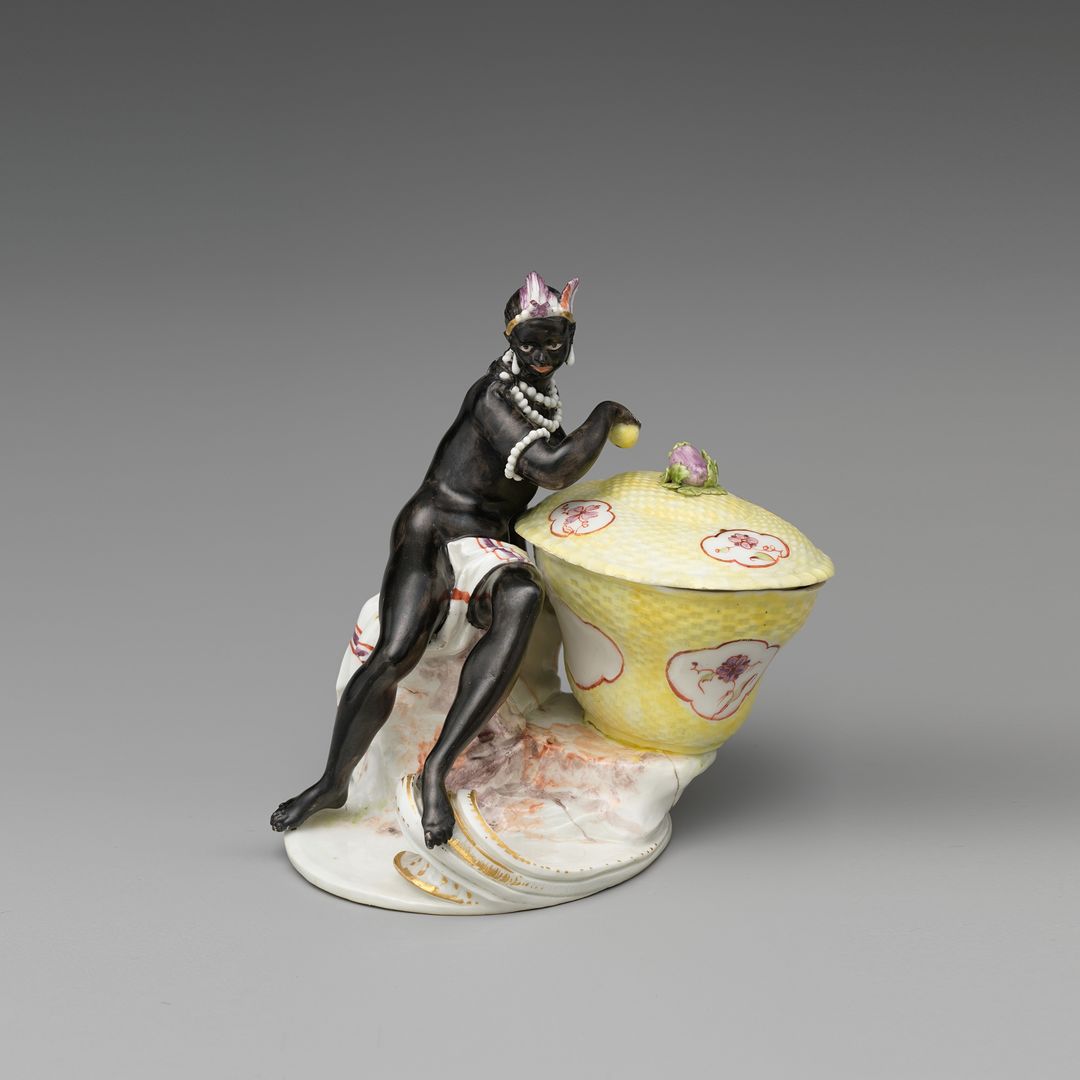On the first floor of The Met Fifth Avenue is a suite of seven galleries containing works of art collected by Jack and Belle Linsky during the early twentieth century in the tradition of Europe’s princely patrons. Chief among the objects are eighteenth-century porcelain figurines originally made as a form of courtly luxury for rulers such as Augustus the Strong, the founder of Meissen manufactory in present-day Germany. When the Linsky Galleries first opened at The Met in 1984, the designers and curators intended to replicate the spirit of the couple’s Fifth Avenue apartment. The display did not feature interpretative labels.
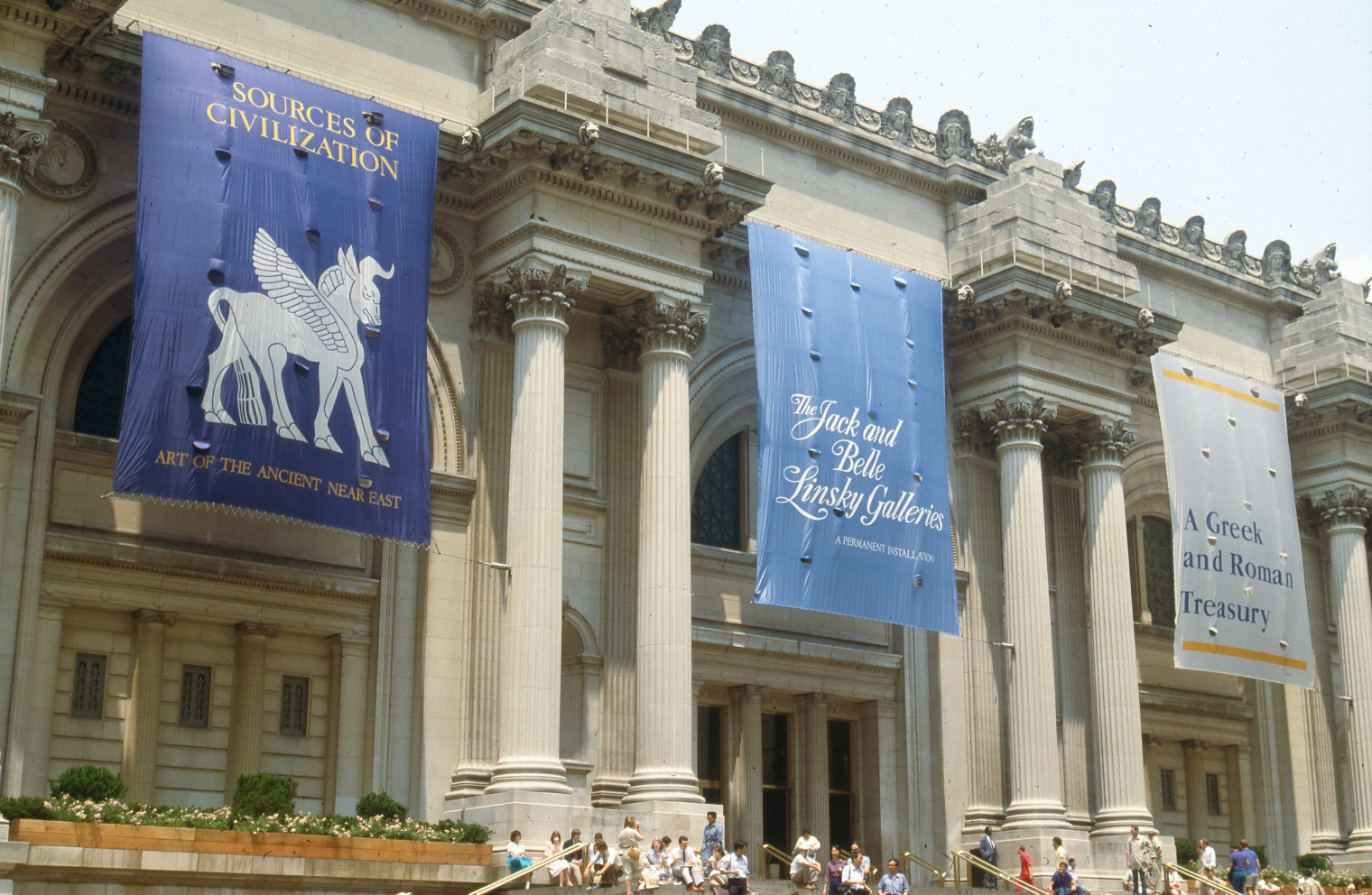
The Metropolitan Museum of Art, Fifth Avenue Façade, photographed in 1984
I’ve often walked through this winding sequence of small galleries as a fellow of the European Sculpture and Decorative Arts Department and overheard visitors puzzled by this collection of porcelain figurines. At first they might look like courtiers plucked out of a pastoral Boucher painting or one of Watteau’s fêtes galante. But at a second glance, some subjects and characters may appear problematic or offensive.
When I first encountered the hunting group, produced by Höchst Manufactory, I was enamored with the curving rocailles of the gilt-bronze base, the vibrant enamel, and the meticulous details modeled in porcelain. At the apex of the scene, two hunters are framed by a wine cooler and a dead stag; the men are celebrating a successful outing.
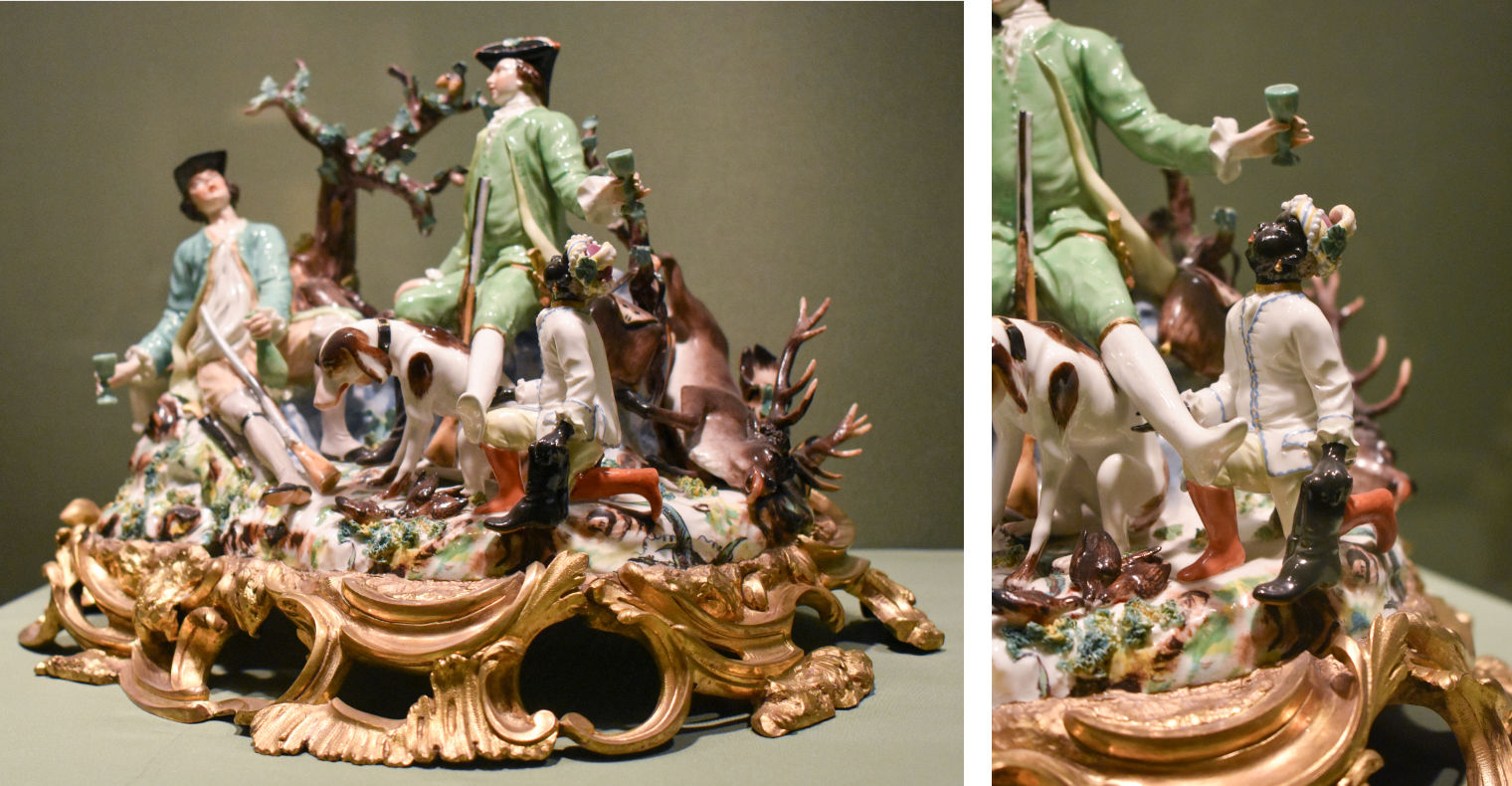
Manufactory: Höchst Manufactory (German, 1746–1796). Hunters with attendant, ca. 1760. Hard-paste porcelain, gilt bronze, height: 9 in. (22.9 cm). The Metropolitan Museum of Art, New York, The Jack and Belle Linsky Collection, 1982 (1982.60.230)
Upon closer inspection, I noticed a third figure kneeling in the foreground. Was he also a hunter? The object label identified the young man as an attendant; however, his deeply pigmented Black skin, sumptuous costume, smaller scale, and gilded neck collar (the latter a symbol of enslavement) differentiates him from his white counterparts. This is a figure known as a “blackamoor,” a historical term used to refer to ornamental, exaggerated, and often caricatured depictions of Black Africans. In studying this and other porcelain figurines like it, a key question arises for me: How can we begin to address these technically sophisticated objects, once imagined by many as the height of luxury, when they appear to us so different today?
With my mentor, Dr. Iris Moon, assistant curator in the European Sculpture and Decorative Arts Department, I saw an opportunity to revisit this area of the Museum’s collection in order to incorporate new narratives. We imagined a project that would reframe the Linksys’ significant collection of porcelain figurines around relevant topics such as race, labor, colonialism, and global commerce. Doing so would highlight the important role of the decorative arts in negotiating these issues.
We set out to write a series of interpretative texts that would help visitors in the Linsky Galleries ask one key question: Why look at porcelain figurines from the eighteenth century today? I found that this task was more difficult than it first appeared. Writing engaging label copy for a general audience is among the most challenging aspects of curatorial work, especially when the artworks in question include racially sensitive depictions.
Why look at porcelain figures from the eighteenth century today?
Eight object labels now guide viewers through Galleries 538 and 543. We selected porcelain figurines from some of the most significant European manufacturers of the period, including Höchst, Meissen, Mennecy, Nymphenburg, and the Russian imperial and Danish royal manufactories, and drafted new texts that position these objects in historical contexts and interpretative frameworks for the first time.
While working on this project, we wanted to be careful to distinguish the early collecting history of the Linskys from this current reinterpretation. I conducted research in The Met archives, which revealed information about the Linskys as individuals and collectors. Jack Linsky (1897–1980) was born into a poor family in northern Russia and immigrated to New York in 1904. Through family friends, Jack met Belle (1904–87), who had immigrated to New York from Kyiv, and the couple married in 1925. Belle was an efficiency expert at the company Jack founded, Swingline—a brand name that has become synonymous with staplers and office supplies. In their life together, they were business partners, philanthropists, and art collectors. After Jack’s death, Belle donated their considerable art collection to The Met. Belle hoped the installation would honor her husband’s life and that the galleries would make people “feel they are visiting the home of a special, intimate friend.” [1]
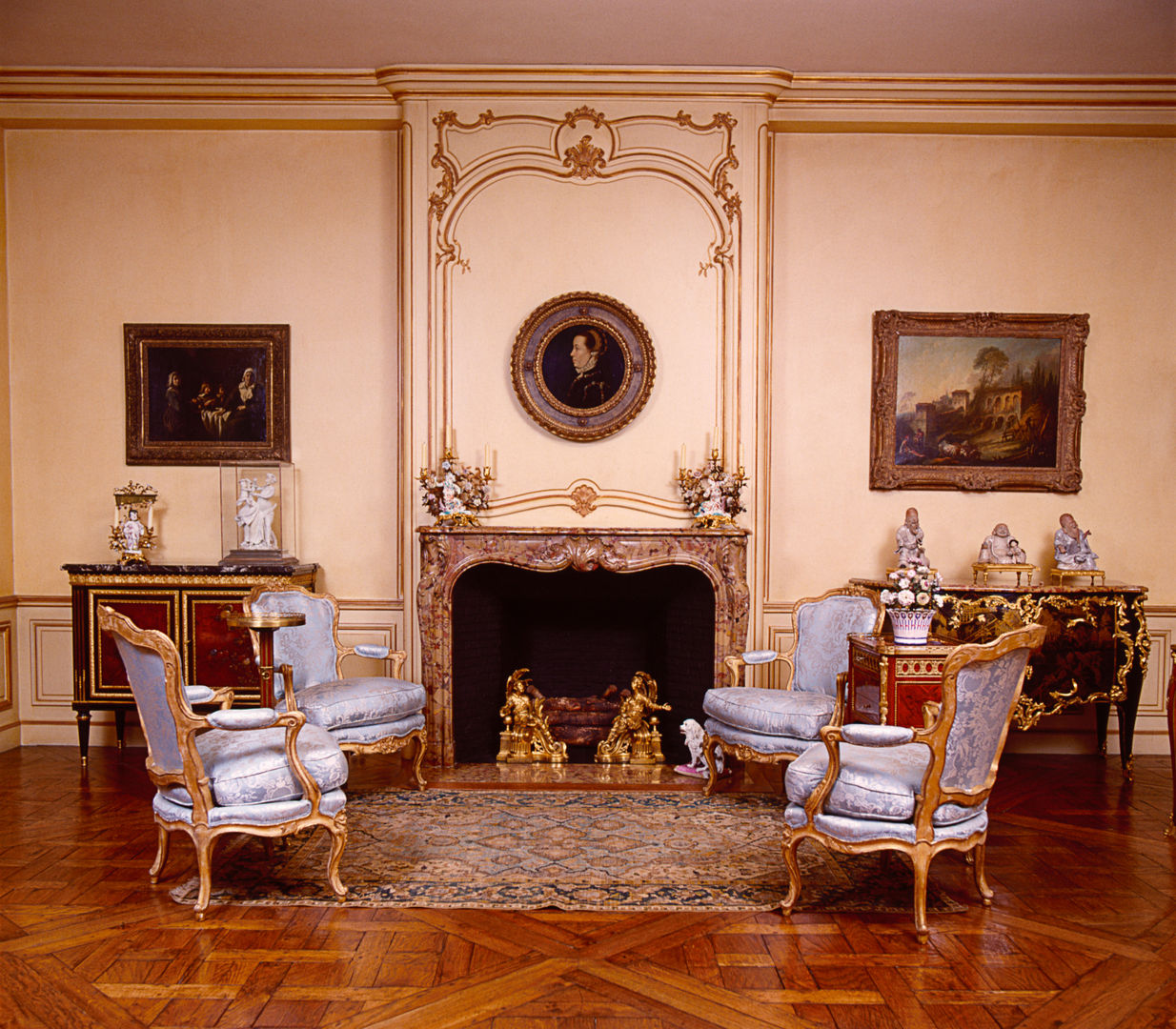
The Linsky residence photographed by Howard Barash in 1982. Photo © Howard Barash
In conceiving the Linsky Galleries at The Met, designers Henri Samuel and Harold Eberhard worked with former curators to transport audiences to the Linskys’ sumptuously decorated Fifth Avenue home. Even before Belle donated their collection to The Met, guests described the Linsky’s palatial fourteen-bedroom apartment as “a museum.” One of their former accountants claimed that some rooms were “roped off because [the collection] was so valuable. You had to sit in another room.” [2] Jack and Belle displayed the majority of their porcelain inside seven cases, with the works arranged by region of production or manufacturer. Met curators maintained a few of the original object groupings, but in some instances, they deviated from the Linskys’ display to create cohesive narratives—for example, grouping commedia dell’arte figurines in one vitrine and pastoral subjects in another.
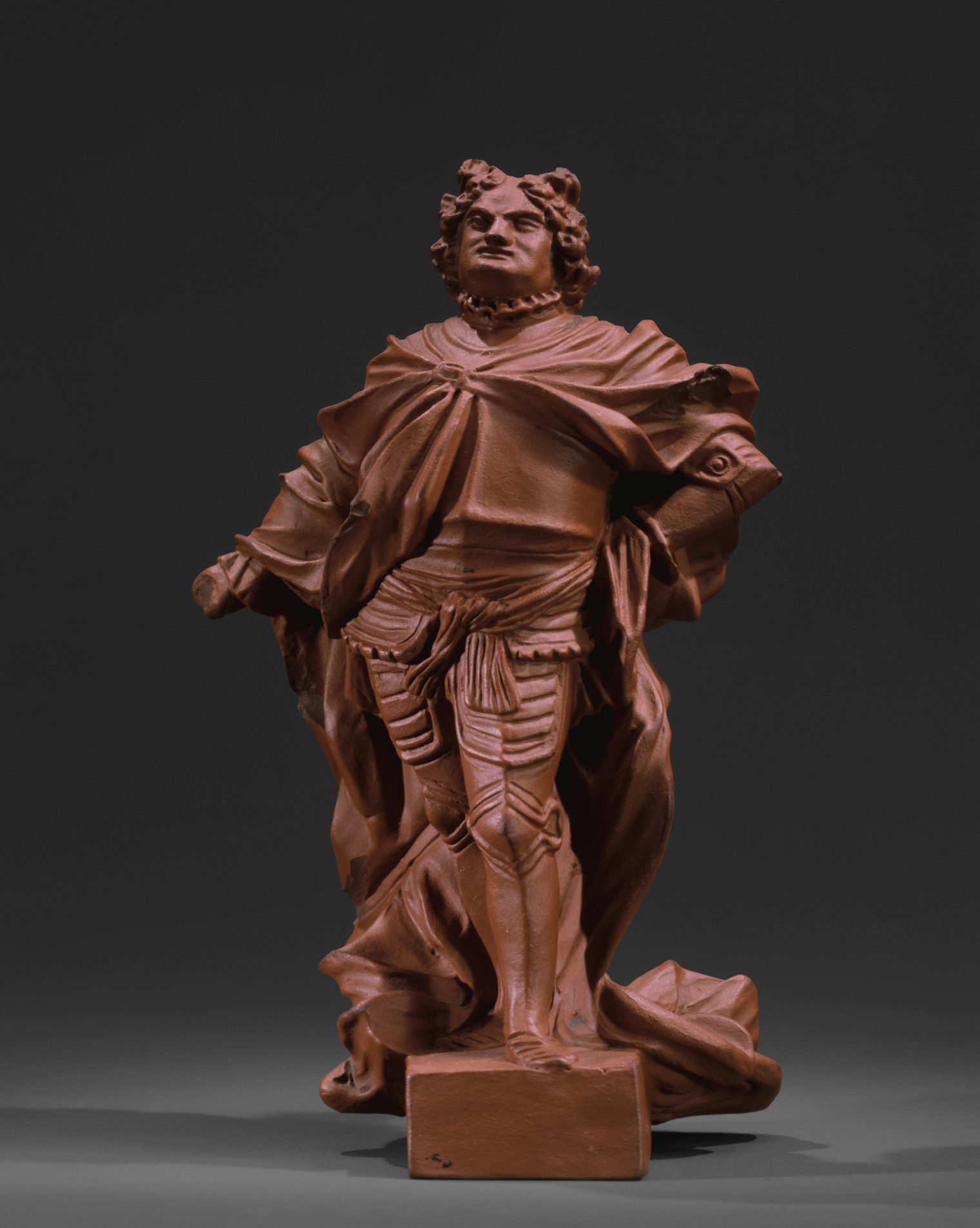
Manufactory: Meissen Manufactory (German, 1710–present). Augustus the Strong, ca. 1713. Stoneware, height: 4 7/16 in. (11 cm). The Metropolitan Museum of Art, New York, The Jack and Belle Linsky Collection, 1982 (1982.60.318)
Though intimate in scale, porcelain figurines made in the eighteenth century were luxury objects used to convey the power and refined taste of the person who possessed them. Each of the works we selected for this project once spoke to its owner’s status, even if we rarely know to whom they originally belonged. In the 1700s, people acquired porcelain figurines in various ways. In London, they could be found at luxury or “toy” shops. In Paris, marchand-merciers sold them, frequently modified to include a sculptural brass mount, a clock, or additional porcelain flowers. Rulers like Elector and King Augustus the Strong and Empress Catherine the Great often commissioned and gifted porcelain to assert their power. In the Linsky Collection, the miniature portrait of Augustus made of stoneware—a predecessor to the hard-paste porcelain developed at Meissen—shows the despot wearing his royal coronation attire, commemorating his political power as the new king of Poland.
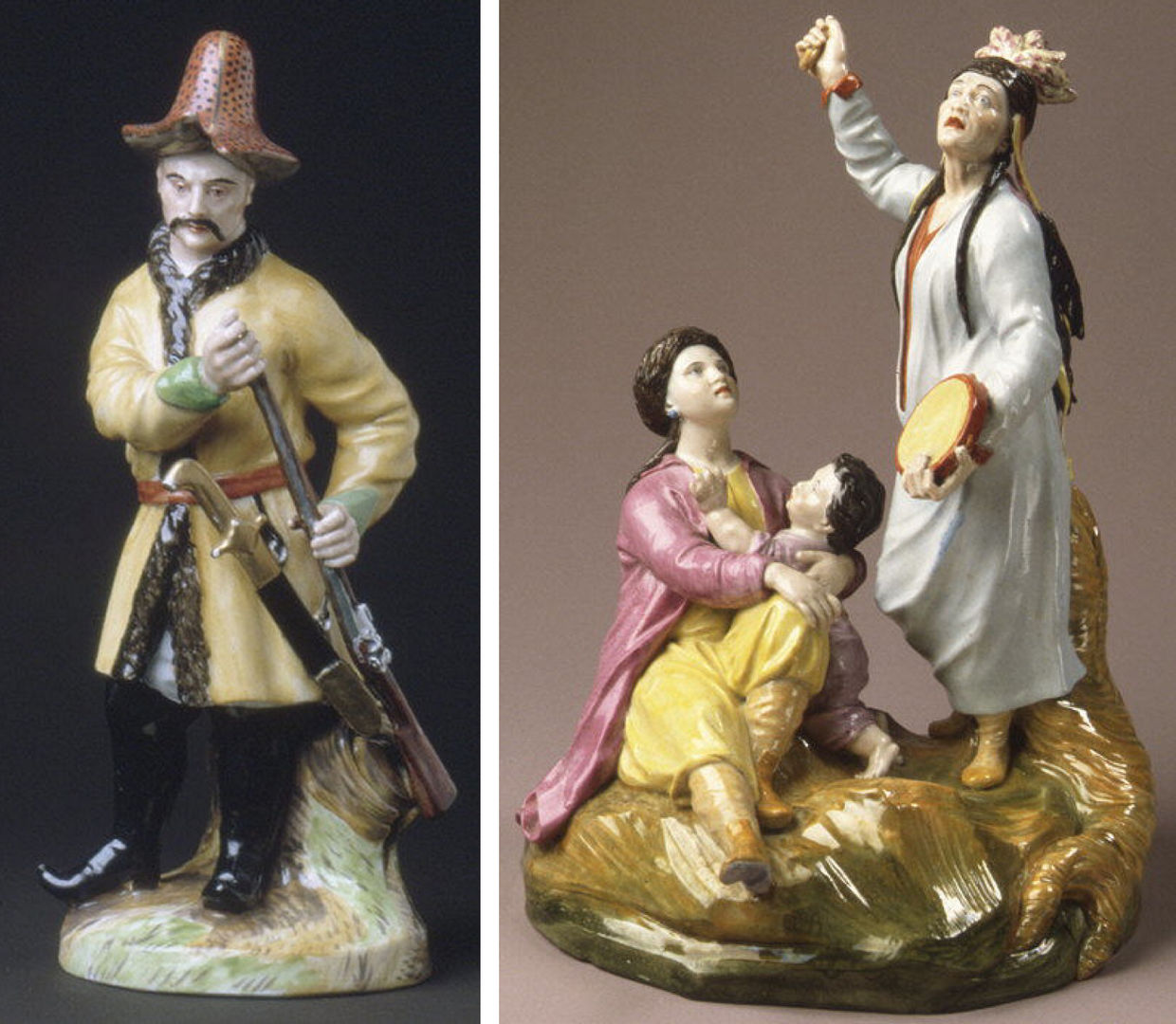
Left: Manufactory: Imperial Porcelain Manufactory (Russian, 1744–present). Kirghiz Man, ca. 1780–1800. Hard-paste porcelain, height: 8 1/4 in. (21 cm). The Metropolitan Museum of Art, New York, The Jack and Belle Linsky Collection, 1982 (1982.60.153). Right: Manufactory: Imperial Porcelain Manufactory (Russian, 1744–present). Female Shaman, ca. 1780–1800. Hard-paste porcelain, height: 10 1/4 in. (26 cm). The Metropolitan Museum of Art, New York, The Jack and Belle Linsky Collection, 1982 (1982.60.175)
Catherine encouraged the Russian Imperial Porcelain Manufactory to produce works such as the People of Russia group. Its depiction of Indigenous peoples, like the Kirghiz man and the female shaman, was a celebration of Russia's colonization of Siberia. [3] Duke Carl Eugen of Württemberg commissioned a set of ballet figurines from his factory in Ludwigsburg to adorn an elegant dessert table on his thirty-fifth birthday. Actual performances he had witnessed inspired the costumes and poses of the dancers. Here we see even a duke harnessing the power of luxury—in the form of locally made porcelain symbolizing his courtly entertainment—as propaganda. [4] By manufacturing and disseminating these Ludwigsburg ballet figurines, Carl Eugen promoted the idea that his reign should be associated with courtly spectacle, luxury, and the technical innovation of porcelain production.

Left: Manufactory: Ludwigsburg Porcelain Manufactory (German, 1758–1824). Modeler: Attributed to Joseph Nees (active 1758–73). Two dancers, ca. 1760–63. Hard-paste porcelain decorated in polychrome enamels, gold, 6 x 6 3/8 x 3 9/16 in. (15 x 16 x 9 cm). The Metropolitan Museum of Art, New York, The Jack and Belle Linsky Collection, 1982 (1982.60.191). Right: Manufactory: Ludwigsburg Porcelain Manufactory (German, 1758–1824). Modeler: Joseph Nees (active 1758–73). Pas de Deux, ca. 1760–63. Hard-paste porcelain, height: 5 7/8 in. (14.9 cm). The Metropolitan Museum of Art, New York, The Jack and Belle Linsky Collection, 1982 (1982.60.192)
Booming global trade routes in the eighteenth century brought a wealth of products to European buyers. Consumables—chocolate from Mesoamerica, coffee from the Levant, tea from Asia, and sugar and snuff (powdered tobacco leaves) harvested by enslaved people in colonized territories in the Caribbean and North America—were prized commodities. These luxury goods spurred demand for specific serving and storage vessels, often made of porcelain, but the culture around their enjoyment is also reflected in porcelain figurines. One figural group shows an anonymous wealthy couple embracing as they consume hot chocolate. The man was likely a member of the Freemasons—a secret classicist society for men—indicated by the Masonic apron in his lap. The attentive pug and the ribbons on the woman’s wrists and collar may suggest that she was a member of Mopsorden, the Order of the Pug, which offered memberships to men and women from the nobility and wealthy bourgeoisie. In this Meissen group, the couple’s social and economic capital is linked to the history of chocolate in Europe; the costs of consuming chocolate (including the vessels and occasional sugar used to prepare it) made it a luxury enjoyed only by the elite.
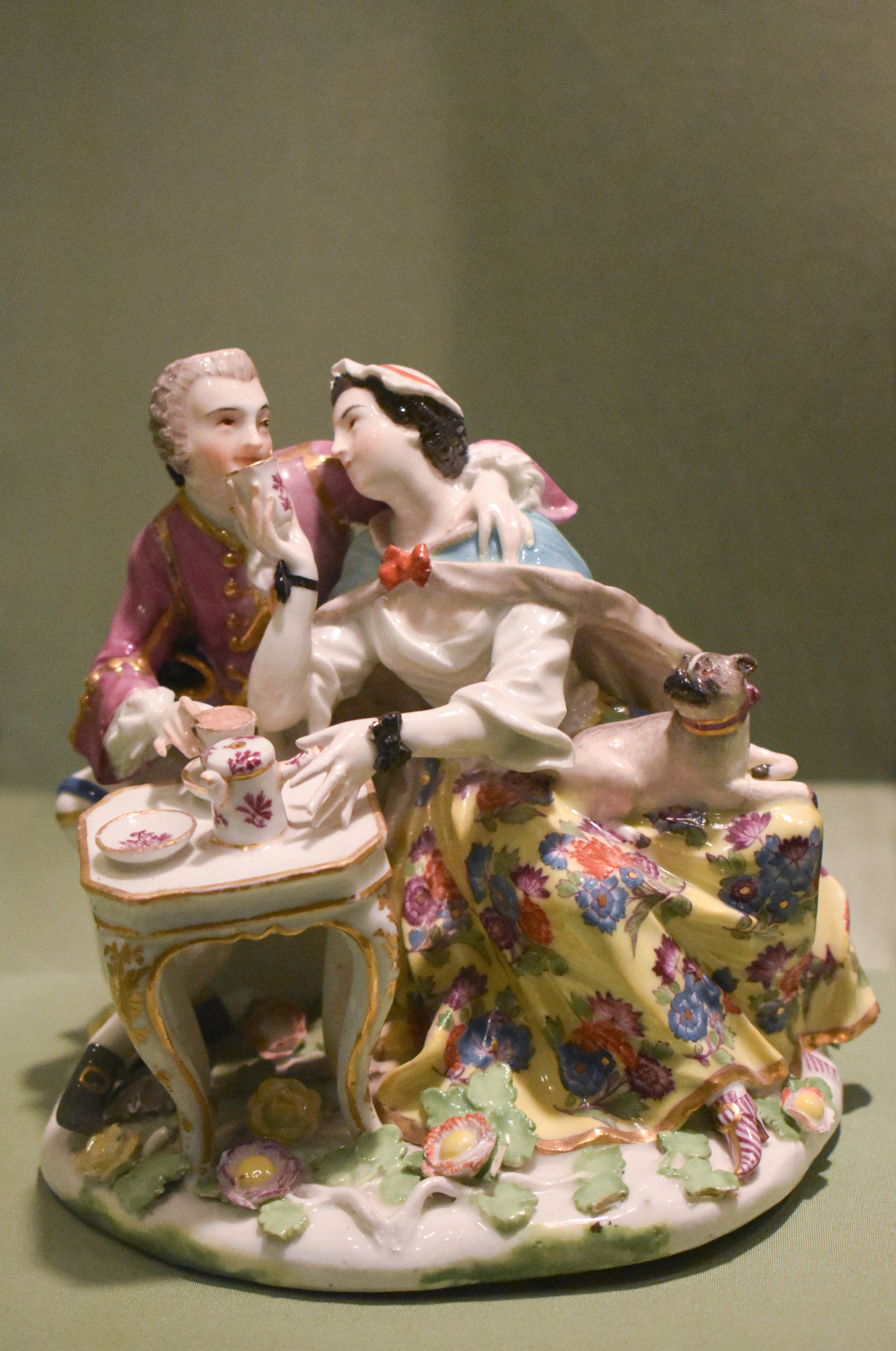
Modeler: Johann Joachim Kändler (German, 1706–1775). Factory: Meissen Manufactory, (German, 1710–present). Couple Drinking Chocolate, ca. 1744. Hard-paste porcelain, height: 5 1/2 in. (14 cm). The Metropolitan Museum of Art, New York, The Jack and Belle Linsky Collection, 1982 (1982.60.326)
For several centuries, elaborate ephemeral sugar sculptures adorned the banquet tables of wealthy European patrons, which were eventually supplanted by porcelain figurines. Like the aforementioned figural group, this pair of sugar boxes with “blackamoor” figures also combines a male and a female body with an edible luxury—this time, sugar. Meissen originated this type of composition, but competing manufacturers in Nymphenburg and Vienna quickly developed their own versions. The tone of these figures, however, differs significantly from that of the couple drinking chocolate. Here, the pairing of the sweet commodity and Black bodies suggests the inextricable links in the Western imagination between luxury, capitalism, and the enslaved labor that harvested sugar.
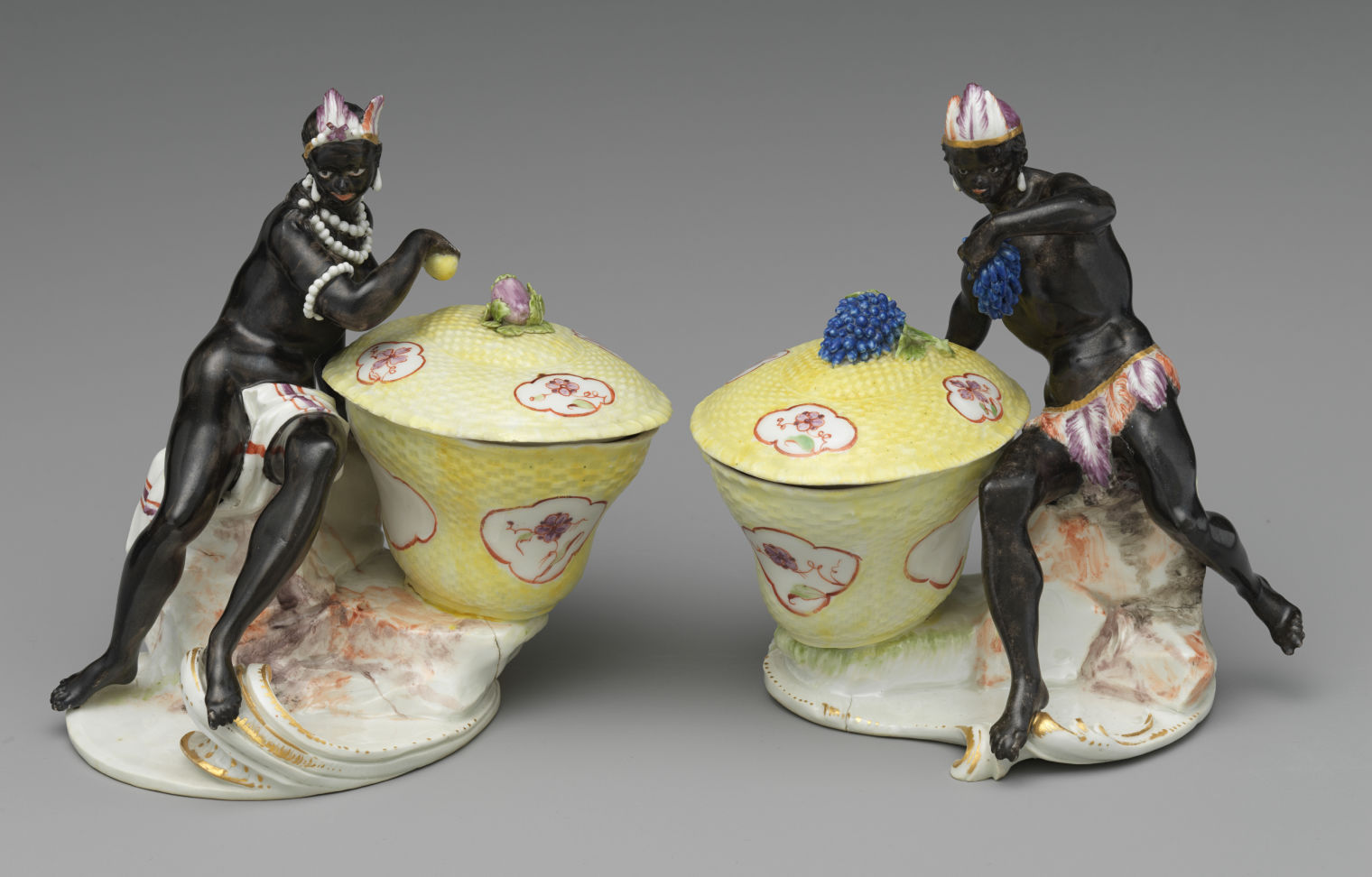
Manufactory: Nymphenburg Porcelain Manufactory (German, 1747–present). Modeler: Franz Anton Bustelli (1720–1763). Sugar box (pair), ca. 1760. Hard-paste porcelain, height: 5 5/16 in. (13.5 cm). The Metropolitan Museum of Art, New York, The Jack and Belle Linsky Collection, 1982 (1982.60.197a, b)
Beneath the luxury, leisure, and courtly entertainment of eighteenth-century Europe were the imbalanced systems of commerce and labor that made them possible. Porcelain figurines reproduced the contemporary interests of elite society on a miniature scale. The diminutive bodies, sumptuous attire, and glittering surfaces can be disarming and seemingly incongruous with the sobering themes implicit in their subjects. The large number of racialized depictions among these figurines raises questions about the purposes they served for consumers at the time. Although some of the examples in the Linsky Collection had a functional purpose, objects like the Meissen nodding pagod indicate aristocratic interests in spectacle and whimsy that devolved into mockery. The figure is depicted with hands hovering above a protruding belly, mouth parted in an open grin, and elongated earlobes that hang just below his jawline. These figures were interchangeably called “pagods” or “magots,” both imprecise and derisive terms used to describe an imagined Chinese or Japanese monk. Many porcelain pagods, including this Meissen example, were outfitted with hidden mechanisms to make the head and arms bobble when touched. Although the Meissen nodding pagod became a widely popular and endlessly copied chinoiserie luxury object, meant to delight and amuse the owner, today it is difficult for many viewers to see beyond the grotesque and offensive racialization of the depiction.

Factory: Meissen Manufactory (German, 1710–present). Nodding Pagod, ca. 1760. Hard-paste porcelain, height: 8 1/2 in. (21.6 cm). The Metropolitan Museum of Art, New York, The Jack and Belle Linsky Collection, 1982 (1982.60.325)
When discussing my research with colleagues and students, many people are surprised to learn that figurines featuring exaggerated caricature based on racial stereotypes are standard works in the history of European porcelain. The fact that large quantities were made, sold, and collected throughout Europe suggests the serious social capital with which these luxury objects were imbued. The development of these works should be understood within the context of the European Enlightenment—a time during which Bernard Mandeville touted the commercial and societal benefits of luxury, while authors like Johann Caspar Lavater and Georges-Louis Leclerc, the Comte de Buffon, developed theories on human variety and invented racial hierarchies. In turn, Edward Long—enslaver, writer, and British supporter of Jamaican plantocracy—based his literary defense of enslavement on many of these Enlightenment philosophies.
In many ways, these debates informed the production of racialized porcelain figurines like the Höchst hunting group, where an unnamed “blackamoor” is frozen in a pose of perpetual servitude. The ubiquitous presence of racialized porcelain figurines, displayed in the domestic interiors of eighteenth-century aristocrats among their voluminous decorative arts collections, served to normalize and reinforce racial hierarchies. In the museum context, the absence of explanatory labels for the Linsky figurines encourages a surface-level reading of eighteenth-century porcelain as an entertaining tabletop garnish. With the addition of these new texts, we hope to contextualize these important objects and explore their changing meanings.
[1] Avis Berman, “The ‘Girl with the Special Eye for Art’” ARTNews (September 1982): 87. Return
[2] John R. MacArthur, The Selling of “Free Trade”: NAFTA, Washington, and the Subversion of American Democracy (New York: Hill and Wang, 2000): 15. This quote came from Howard Pollack, of H.T. Schwaeber & Co., Jack Linsky’s former accountant and tax preparator in the 1960s. Return
[3] Jack and Belle Linsky began amassing this collection of Russian figures in the 1940s, purchasing one piece a year from the “personal collection” of a Russian dealer named Popov. Years later, Belle Linsky said she “was invited to go to the warehouses of the [Popov Porcelain Factory] museums. But they didn’t have any eighteenth-century porcelain there. Of course not… I have it!” Gary Graffman, “The Natural,” Connoisseur Magazine (June 1983): 87 – 88. Return
[4] Clare Le Corbeiller, “Figures to Adorn the Middle of the Desert,” Figures from Life: Porcelain Sculpture from The Metropolitan Museum of Art ca. 1740-1780. Edited by Cynthia Duval (Boston: Museum of Fine Arts, 1992): 9. Return
